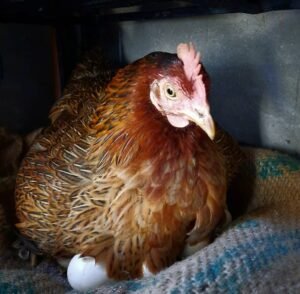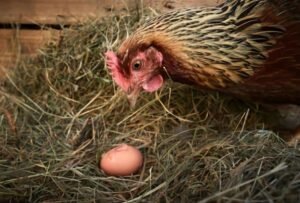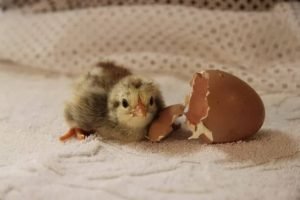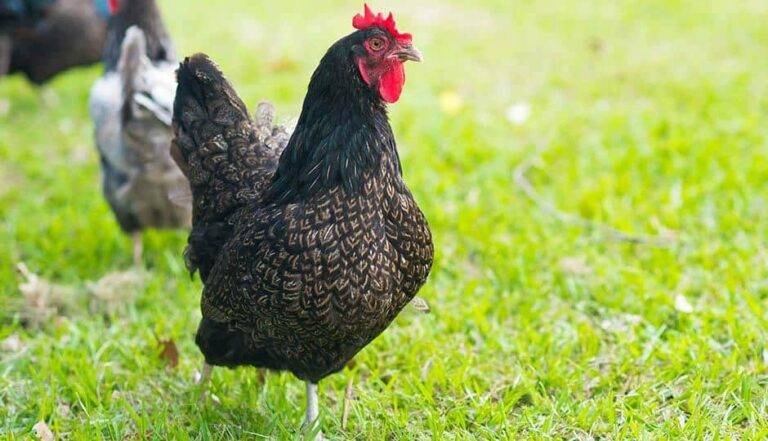New Hampshire Chicken – Characteristics, Origin, Breed Info and Lifespan

If you want an excellent breed of chicken that has good egg-laying capacity and produces quality meat, then consider the New Hampshire chicken.
There are a lot of fascinating things about this chicken breed that will excite you.
I urge you to sit tight as we zoom into the characteristics, lifespan and other features of the New Hamsphire chicken.
This guide will provide you with enough information that will help you to make the decision whether to get this chicken or not.
So, if you are ready to learn more, lets’ dive right in.
What is a New Hampshire chicken?
The New Hampshire chickens are Rhode Island Red descendants.
They are selective birds that are recognized for their fast-growing, early maturing and meat-producing quality.
Usually, they are bred for it.
And because of their robust and friendly nature, they make great pets.
What is the origin and history of New Hampshire chickens?
The New Hampshire chicken is a strain of the Rhode Island Red Chicken.
They came into existence in 1915 as a result of the need for more chicken qualities.
Its invention was in response to the need for rapidly growing, fast feathering and vigorous birds which mature early.
The New Hampshire chicken was born with these strategic traits.
In 1935, the American Standard Perfection admitted the New Hampshire breed.
After an appeal from the fourth-grade students at Canaan Elementary School, New Hampshire was designated as the official State Poultry.
This was done by the New Hampshire legislature in 2018.
They were initially used in the Chicken of Tomorrow contests, which led the way for the modern broiler industry, and they were also used to develop the Delaware breed of chicken.

What are the characteristics of New Hampshire chickens?
1. They have a deep broad body:
The New Hampshire chicken breeds have broad bodies.
This peculiarity makes them a little bit more macho than most birds.
Many say they are medium heavy in weight.
2. The New Hampshire chickens are broody and docile birds:
If you’re interested in having chicks, New Hampshire stands a chance of giving you many.
We know this breed to go broody.
This attribute makes them really great mothers.
In addition to that, they are docile birds.
3. The Feathers of the New Hampshire chicken are attractive:
Usually, you see the normal feathers, then pin-like feathers.
The pin feathers are reddish, brownish buff in colour.
4. New Hampshire chickens have multiple colours on their body:
These birds are characterized by some unique colour traits.
Their tails have some kind of black daint.
The hens, on the other hand, have some neck feathers tipped in black.
Usually, their beaks are reddish, eyes; reddish-bay, shanks; yellow with hints of reddish-horn.
But the New Hampshire chicks are little buff-orange-coloured balls of fluff with some lighter-coloured patches on their undersides.
5. This breed of chicken are single combed:
The combs of New Hampshire are single.
And most are often medium in size with bright red colours.
The combs of the female New Hampshire lops over a bit.
This makes them very easy to identify.
6. They are a Dual-purpose chicken breed:
Just like most chickens, the New Hampshire chicken is a dual-purpose chicken.
They are mainly raised for meat.
But they produce quite a number of eggs.
7. The New Hampshire chicken breed weighs between 2.5 – 3.9 kg:
Although a chicken’s weight depends on how well-fed they are.
On average, the New Hampshire hen weighs 2.9 kg while the roosters weigh about 3.9 kg.
On the other hand, the pullets weigh around 2.5 kg, while the cockerels weigh about 3.4 kg.
8. They are free wanderers and amazing foragers:
With their strong legs, they tend to make good foragers.
They love to walk around the yard in search of grubs.
Usually, they thrive well in a run or wandering free environment.
9. New Hampshire chickens are poor flyers:
Unlike the Leghorn chicken breed, the New Hampshire chicken does not fly very high.
Therefore, you do not need a high fence. Or some kind of covering to keep them aware from the next yard.
10. The New Hampshires are highly tolerable
You wouldn’t find them bullying each other or other birds.
On the flip side, they are not aggressive.
If you check well, you might find them making peace other than starting war like the Plymouth Rock Chicken.
Table summarizing the New Hampshire breed information
| Skin colour | Yellow |
| Egg colour | Brown |
| Comb type | Single |
| Setter/Broody | Yes |
| Especially Docile | Yes |
| Use | Dual-purpose breed |
| Cold Hardiness | Hardy in winter |
| Conservation status | On the watch |
| Heat Tolerance | Not especially heat hardy |
| Also Known As | New Hampshire Red |
| Personality | Placid, friendly, hardy and tolerant |
| Country of origin | United States of America |
| Standard | New Hampshire Red |
| Bears Confinement | Bears confinement well |
| Weight | Male: 3.9 kg (8.5 lb) Female: 2.9 kg (6.5 lb) |
| Varieties | New Hampshire Reds |
Why choose New Hampshire chickens?
Why is the New Hampshire chicken a good option to add to the backyard poultry?
Well, this question will depend on many factors.
One of which is why you want this chicken breed.
Below are some of the reasons why the New Hampshire chicken is a great choice;
1. They New Hampshire chickens are gentle birds:
Have you ever had a go easy kind of neighbour who doesn’t seem to be perturbed by anything and everything?
That’s the kind of chicken the New Hampshire breeds are.
They’re the happy-go-lucky kind of birds.
They just want to free-range, make friends and eat.
2. The New Hampshire hen are good mothers:
Because they’re good brooders, they make great mothers.
Also, they serve as a foster mum to other chicks
And surprisingly, they do this effortlessly.
Their caring nature can make them act like mums to the big birds.
3. They are not affected by winter:
If you need a chicken that can deal with cold head-on, then the Hampshire chicken breed is your best bet.
They are hardy birds that survive in chilly and frigid climate conditions.
You can attribute this trait to their full and fluffy feather coats.
Also, their heavyset bodies account for this insulation.
4. The New Hampshire is full and fluffy:
This very quintessential breed is full-bodied.
Its body is carried by strong legs.
Their small and curious face sits on a lovely well-curved neck.
In simple terms, they are fair to look upon.
And they can serve as the best table fowl.
5. New Hampshires are the quadruple R chickens:
Wondering what that could be?
They are relaxed, very reliable, ready to hug and robust.
Usually, their relaxed nature makes them great pets.
And talking about reliability, their egg-cellent egg-laying ability is not haunted by summer or winter.
Also, their robustness makes them the perfect chicken for the table.
6. They are easy to care for:
These chickens do not have much of a problem when it comes to caring.
This makes them very ideal for beginners.
They are genetically strong birds, with robust chicks.
Usually, they rarely fall sick.
7. They are good for meat:
Although they are good egg layers, they are best for meat.
We can attribute this to their robustness and fluffy body.

What are the disadvantages of having the New Hampshire Chickens?
The New Hampshire chickens are good buddies.
But beyond their gentleness are some traits that may not sit down well with you.
They include;
1. New Hampshire chickens are rare:
Although they are not endangered birds, they are rare.
They may likely go out of existence soon.
2. You may end up with an aggressive New Hampshire rooster:
Although the hens are non-aggressive, the same cannot be said of the roosters.
They are a mixed bag. You don’t know which you will end up picking.
Some may be aggressive. Many won’t be.
3. New Hampshires may destroy your backyard and garden:
On the flip side of being a good forager, they tend to “over forage”.
If your backyard is sandy, you may end up getting a well dug for free.
And if your backyard is small, they might make a wasteland.
And that doesn’t sound good.
4. Your New Hampshire chickens may be prone to frostbite on their combs:
Although they fairly get cold, watch out for their combs.
They may get frostbite on their comb.
But you can salvage that by getting a jar of Vaseline. Just for them.
5. New Hampshire chickens are fairly heat tolerant.
Because they do not have down feathers that help to keep them warm in the winter, they are not very heat tolerant.
Frequently Asked Questions About New Hampshire chickens
1. What is the lifespan of New Hampshire chickens?
You can expect them to live for around 7 years.
That’s on an average scale.
2. Are New Hampshire chickens good for meat?
Yes, they are.
The New Hampshire is a dual-purpose chicken, selected basically for meat than egg production
They are the best table fowl chickens.
Giving the dinners are a large chunk of meat from each bite.
3. Can New Hampshire chickens be trained as pets?
If you ever want something more fluffy to hold, then this one great buddy you will get.
Their full and fluffy feathers welcome affection.
Her gentleness makes it easier for both the young and old.
The New Hampshire chicken breed is great for families.
Absolutely good with kids.
Train them well, you will have them eating a treat or two from your hands till they die.
4. Are New Hampshire chickens good egg layers?
While mainly raised for meat, they are also average producers of brown eggs.
Some strains of the New Hampshire chicken breed lay dark brown shell coloured eggs.
On average, they lay about 240 eggs in a year.
In other words, they’re not really egg-cellent.
But on a scale of 1 to 10, they are on 6.
5. How often do New Hampshire chickens lay eggs?
On average, the New Hampshire chicken lays about 3 eggs in a week.
This accounts for about 240 eggs in a year.
Although not as egg-ceptional as the Cochin Chickens which lay about 320 eggs in a year.
But you can count on large eggs when it comes to the New Hampshire chicken.
6. What do New Hampshire chickens eat to grow big?
A good feed with high protein content is enough to make them fat.
But you can allow them to forage to find some grubs and mealworms on the table.
Because of their robust nature, you don’t need to do much to get them to grow big.
7. How fast do New Hampshire chickens grow?
On a general note, they grow pretty fast.
At 2 weeks, they have this “awkward” growth.
As they grow, they develop this beautiful golden red-brown or chestnut red plumage.
Usually comes out in the 6th week.
8. Are New Hampshire chickens noisy?
Not really.
The New Hampshire chickens are not noisy chickens.
Their gentleness and non-aggressive nature make them keep a low profile.
Whether you’re living in an urban or rural area, somehow the neighbours can adjust.
Reason being that it is moderately noisy.
Even when they sing the “chicken food song”
9. What is the habitat and environment of New Hampshire chickens?
A free-range system will keep the New Hampshire chicken in good condition.
Also, their preferred roost height is 2 to 4 feet (0.61 to 1.22 m).
Although they are cold-resistant, warning and insulating the coop will do much good.
Proper ventilation, a good supply of absorbent and dust-free bedding like hemp will be a great addition.
Also, keep the coop dry because moisture is the number one culprit for frostbite in hens.
Conclusion
The New Hampshire chicken breeds are thrifty birds.
And if you’re considering a dual-purpose chicken, they are perfect for the farm.
References
- 12 Best Chicken breeds for Eggs – chicken breeds for eggs
- When Do Chickens Start Laying Eggs Regularly?
- How Many Eggs Does A Chicken Lay In A Week?
- Fermenting chicken feed – The definitive guide
- 10 Sure Ways To Stop Chickens from Eating Their Eggs [+Bonus]
- 6 Best Chicken Egg Incubators for Chicken Eggs and Other Birds











